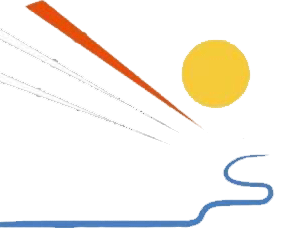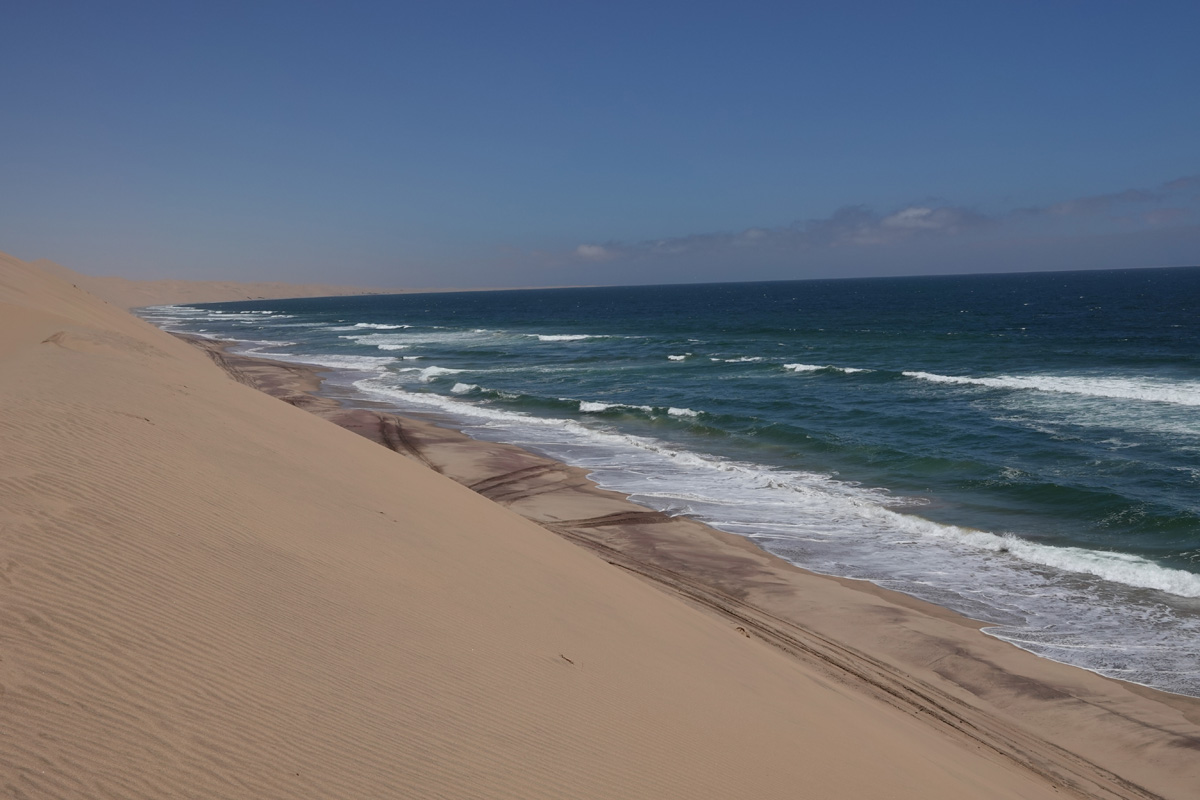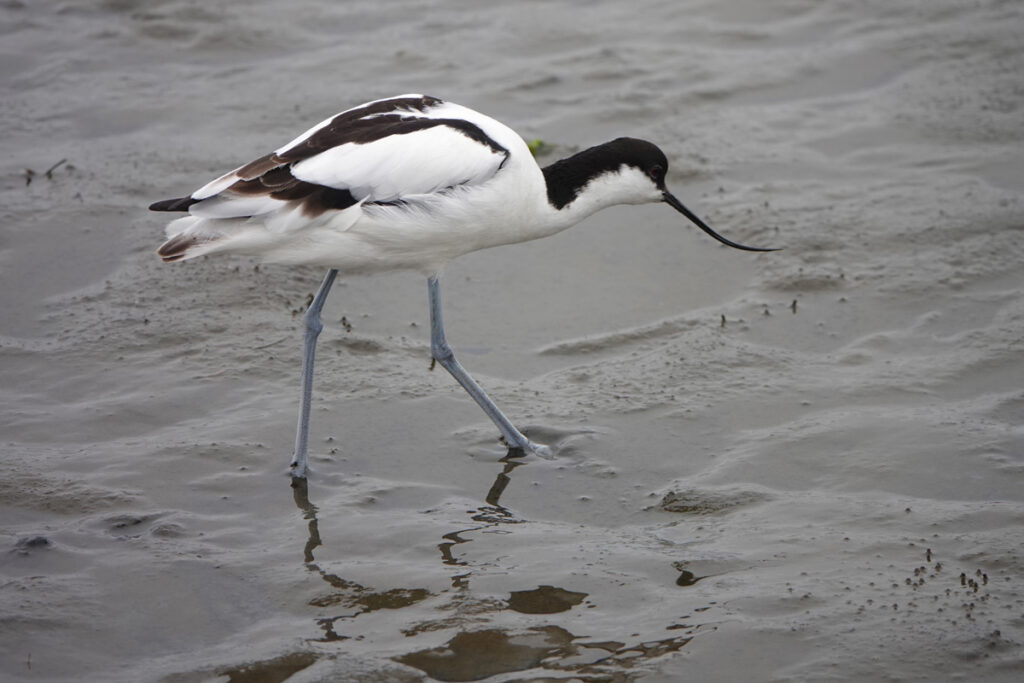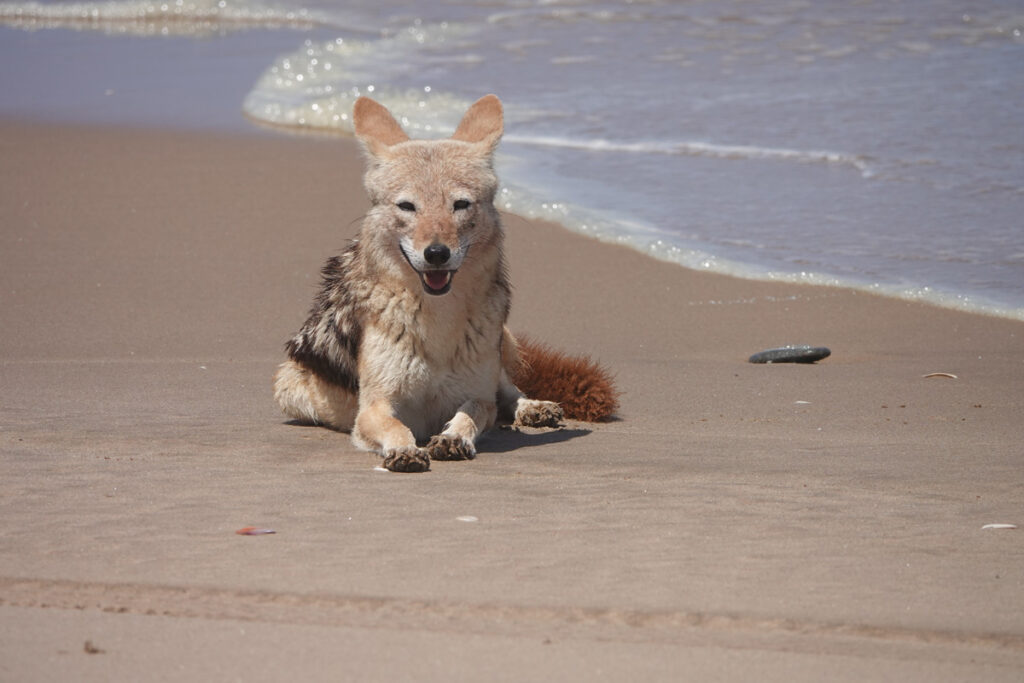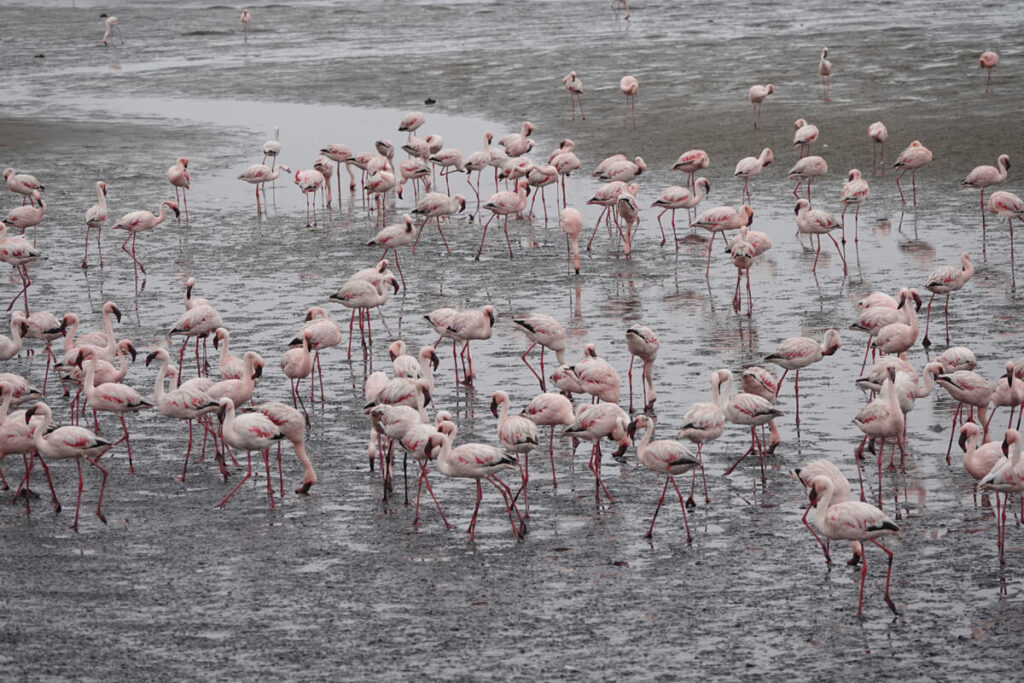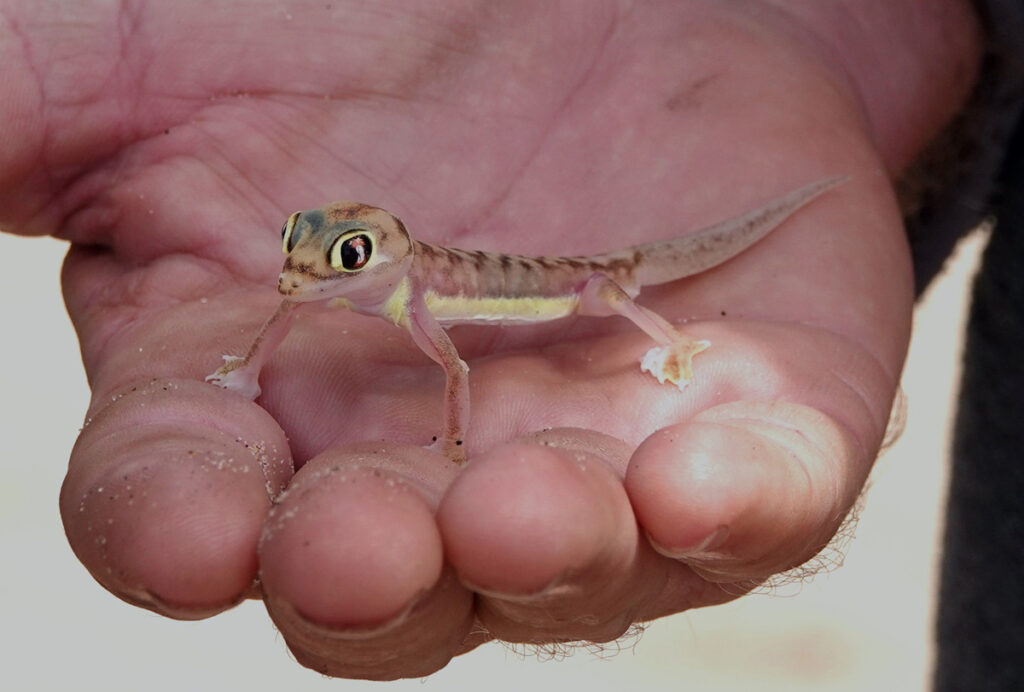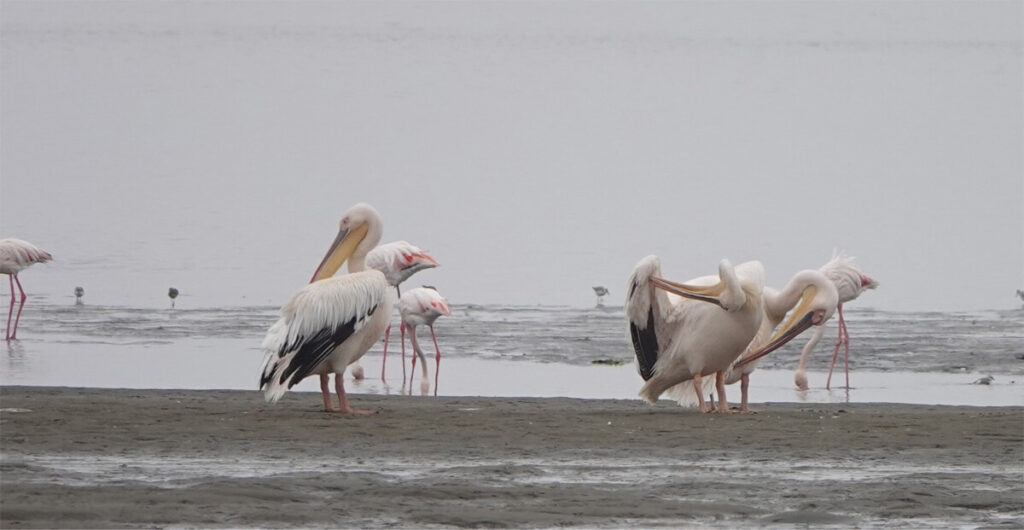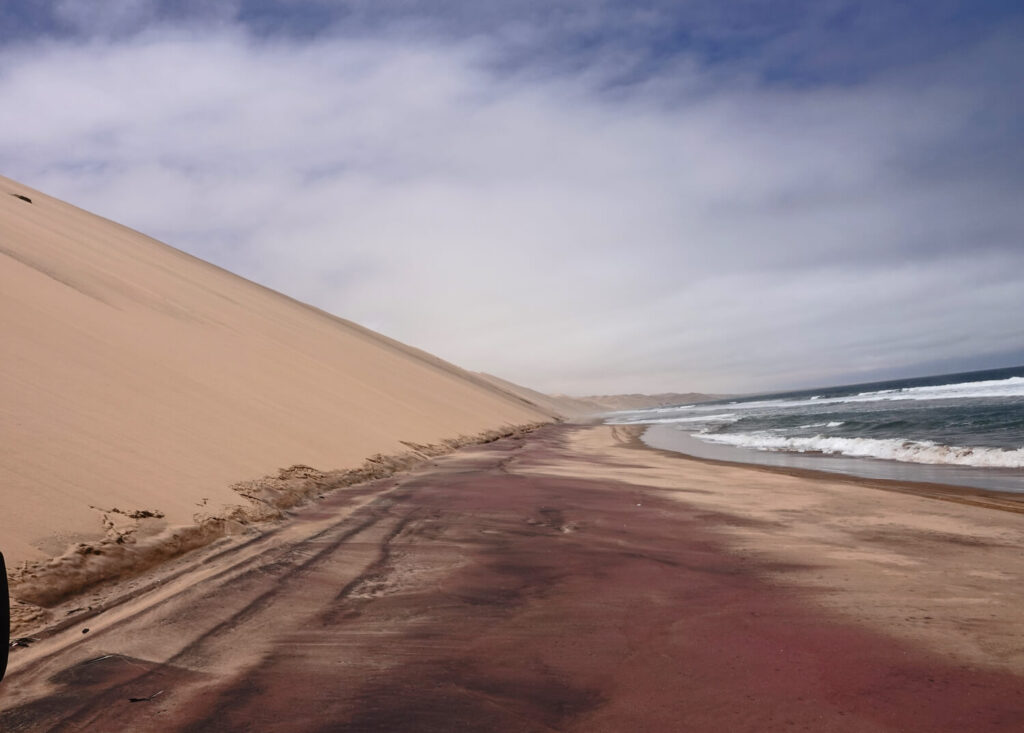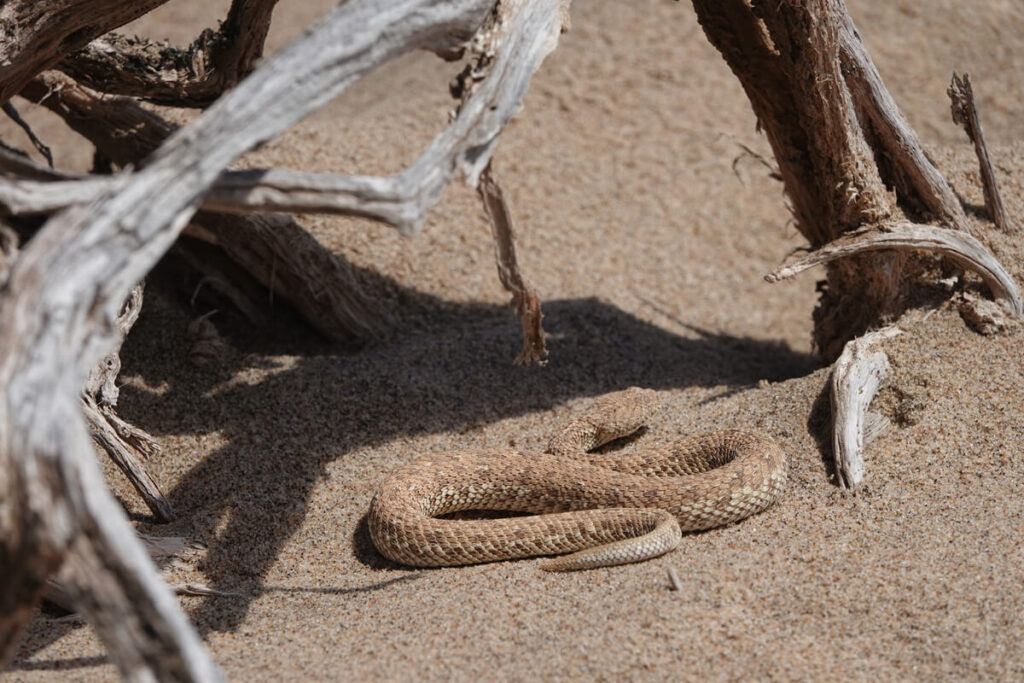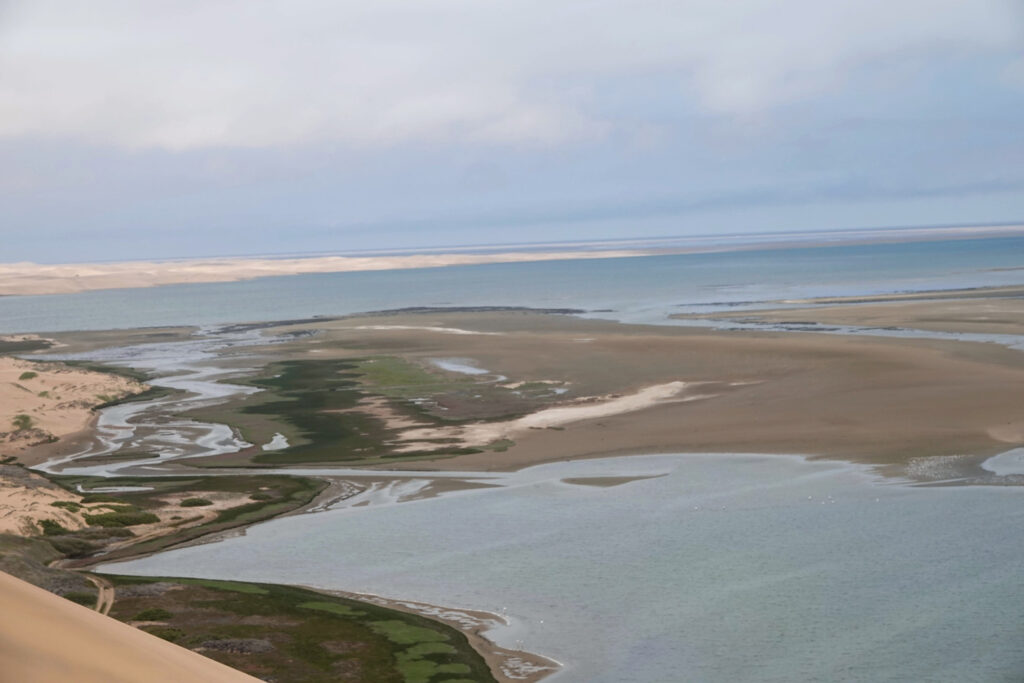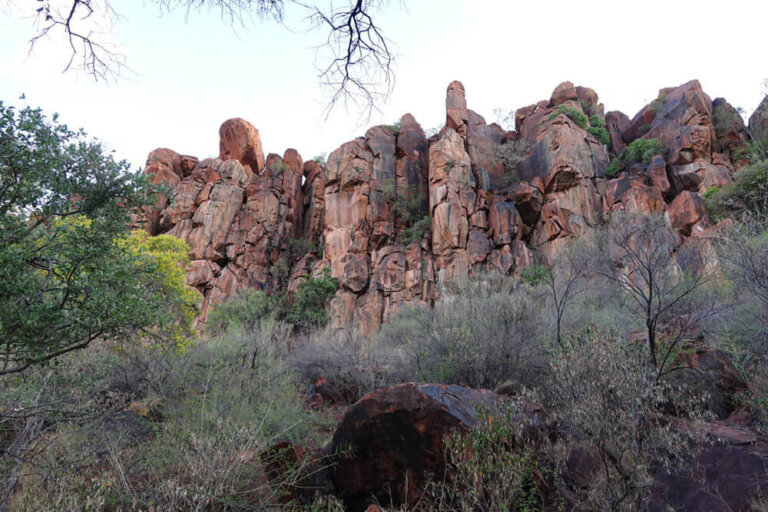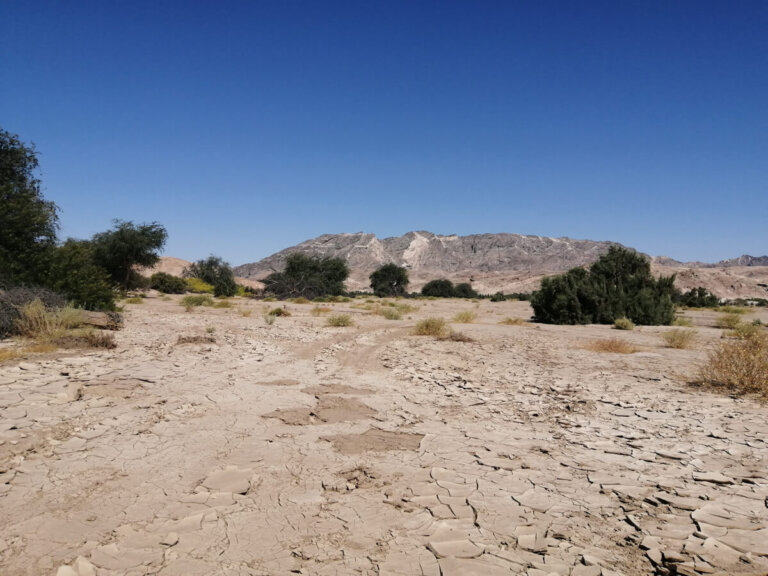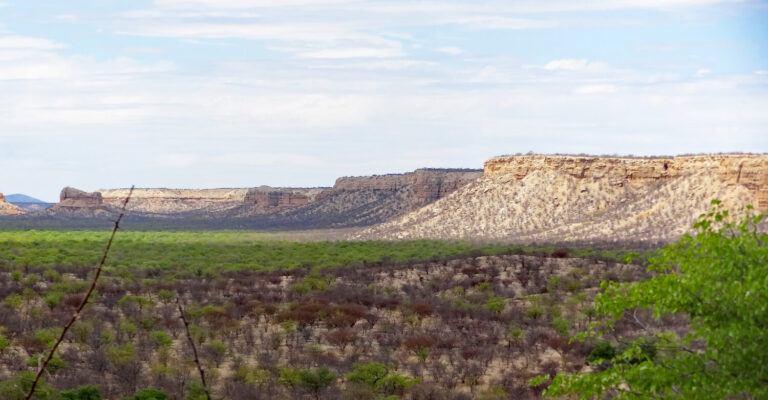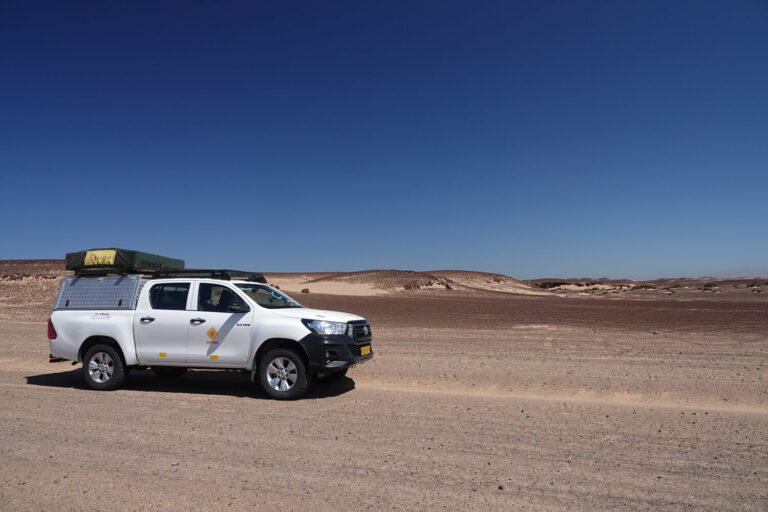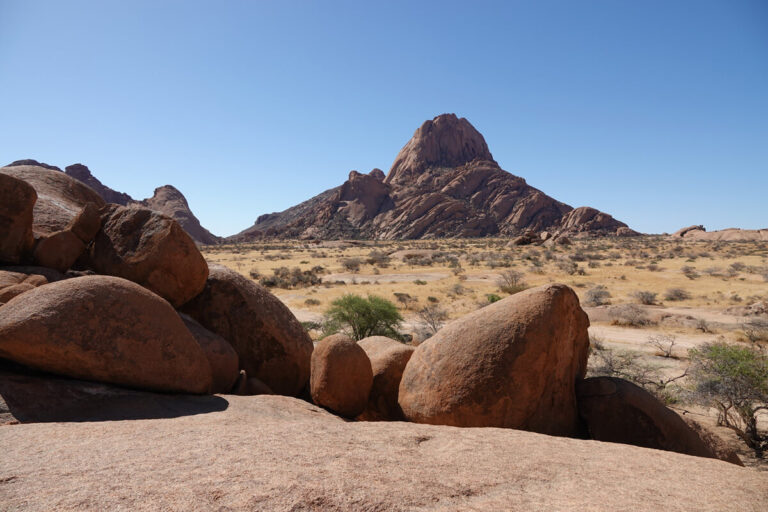Jour 7 : Walvis Bay and Sandwich Harbour
We leave very early. This day is the highlight of our trip to Namibia. We meet a Turnstone guide at our hotel, the Blue Lagoon, at 8.30 a.m. to visit the dunes of Walvis Bay and the Sandwich Harbour lagoon.
Arriving at the Blue Lagoon, no sooner have we dropped off our luggage than our guide comes to collect us. A young Italian couple is already settled in the Land Cruiser. Rudy, our guide, stops the car at the entrance to the road along the shore and suggests a walk along the dike for some bird-watching while he prepares the vehicle: deflating the tires and filling up with fuel. The gloom hasn’t yet lifted, and we’re hoping for a sunny day.
We’re lucky: the tide is going out, so we can walk along the narrow strip of sand between the dunes and the ocean. Flamingos, avocets and pelicans enjoy the mud deposited by the tide.
The Land Cruiser takes us along the tarmac road towards the dunes. We pass the Walvis Bay salt flats. After about twenty kilometers, the road stops and we enter the desert. Rudy stops the car and leads us out. We admire the expanse of small dunes while our guide seems to be looking for something. He comes towards us with a tiny lizard, a gecko palmato. It’s almost transparent, with big eyes. During the day, it buries itself in the sand, while at night it feeds on insects and drinks condensation from the sand and its large eyes, which it licks with its long tongue. It measures just 6 or 7 cm and can withstand temperatures of up to 60 degrees.
A few steps away, a small snake hides under a bush and flees as we approach. It moves sideways. Only a few species have this characteristic: they are sindewinder snakes. Their venom can be fatal. The sindewinder snake that lives in the Namibian desert is the Peringuey viper. It measures around twenty centimetres. Like the small gecko, it protects itself from the heat during the day, and at night it also drinks by licking its scales.
Continuing our hike along the ocean shore, we come across a jackal lying next to a young fur seal it has just killed. A scavenger, it waits for all life to escape from its prey before eating it.
We arrive at the point where the dunes meet the ocean; here the dunes can sometimes exceed 100 m in height and tumble into the ocean.
Rudy explains that the streaks of pinkish-purple sand beneath our feet are grains of precious and semi-precious stones carried by rivers into the ocean, which then releases them with the tide. In a macro photo, he shows us diamond and ruby chips.
While Rudy prepares lunch by the sea, we climb a high dune. From the top, the view of Sandwich Harbour lagoon is spectacular. This freshwater lagoon has given rise to a unique wetland. The lagoon is bordered by a reedbed fed by a freshwater spring, called ‘Anixas’, which in Topnaar means ‘the place of the birds’, because a large number of species congregate here.
Offshore, sprays of foam catch our eye: the back of a whale emerges from the water, accompanied by a dolphin.
As the tide rises, it’s time to leave. The beach becomes too narrow and our experienced driver launches the Land Rover to the top of the dunes. We take one last look at the breathtaking landscape as the ocean seems to swallow us whole.
Our wise ride turns into a sporting rally. The Land Cruiser glides up and down the dunes, giving us a real adrenalin rush. We come across a few springbok lost in the middle of this ocean of sand. In the distance, a herd of oryx, escorted by an ostrich, graze peacefully away from any human danger.
Au retour sur la route, nous repassons devant les salines. Le sel récolté ici est destiné à la consommation namibienne et exporté, notamment en Europe pour usage routier.
The tide has scared off the flamingos, but they’ll be here tomorrow. This evening, the gloom has returned and the wind is cold. This drizzle is characteristic of the Namibian coast, where rainfall is rare and very light. This fog, providential to the survival of desert animal and plant species, generally forms in the evening, due to the temperature difference between the cold Benguela ocean current and the continental heat. During the day, the fog thins out, but the sky is often overcast, creating a special coastal atmosphere.
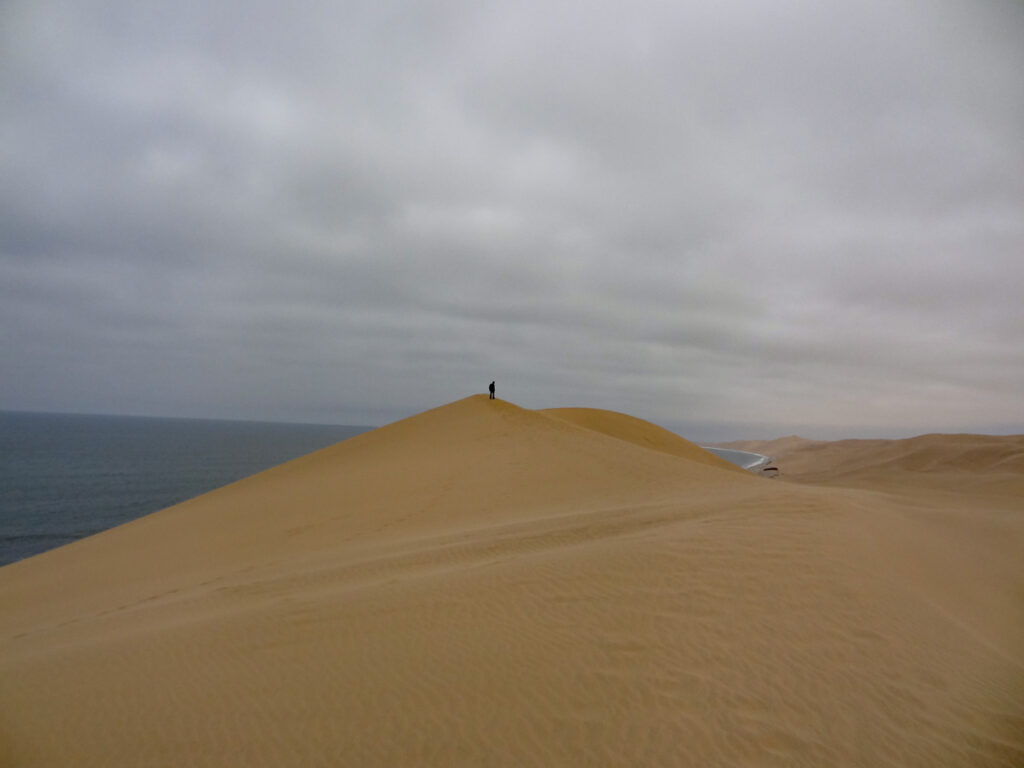
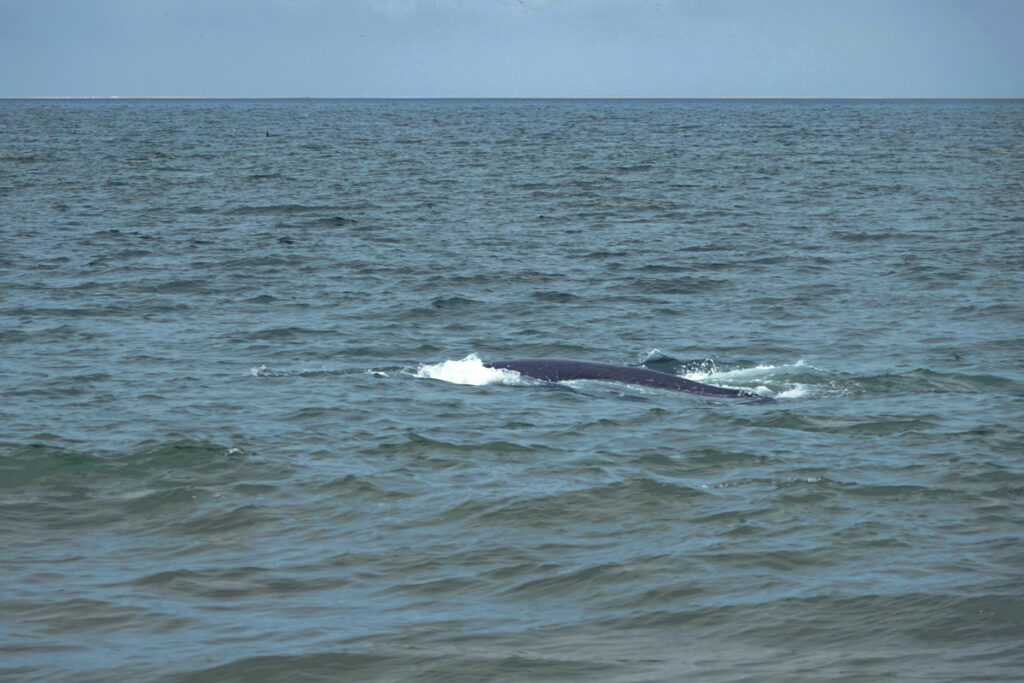
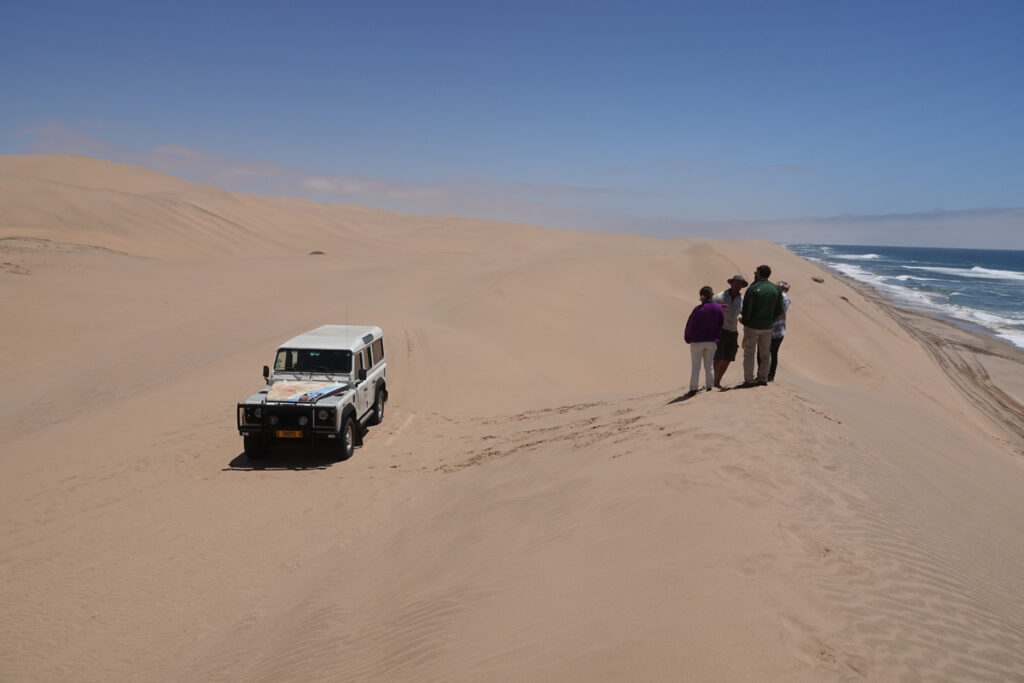
In the middle of the 14th century, Europeans were convinced that the earth was flat and that the universe revolved around it, so the ocean was a place of frightening myths. Adventuring on the high seas was a challenge that Prince Henry, known as Henry the Navigator (1394-1460), son of King John I of Portugal (1325-1433), set his sights on for both economic and religious reasons.
Henry the Navigator founded a circle of eminent cartographers, navigators and astrologers from all over Europe, endowing Portugal with extensive maritime know-how, including astronomical navigation. They invented the Caravelle, the coastal vessel that enabled Bartolomeu Diaz (1450-1500) to conquer the route to India. During this expedition, on December 8, 1487, Bartolomeu Diaz docked the Sao Cristavao in a gulf he christened “O Golfo de Santa Maria da Conceiçao” (The Golf of Saint Mary of Conception), today’s Walvis-Bay, before rounding the dreaded Cape of Good Hope in 1488.
It wasn’t until the early 19th century that the special nature of Walvis Bay attracted the attention of European powers. The only deep-water port on the southern Atlantic coast became the focus of geopolitical rivalries between German and British colonial ambitions, and later between the British Empire and the South African government. In 1994, two years after its independence and after bitter negotiations, Namibia was able to reintegrate the port of Walvis-Bay.
Today, the small town of Walvis-Bay, in addition to being a port of prime economic importance for the country, attracts many tourists thanks to its exceptional geographical location between ocean and desert.
ROAD TRIP IN NORTH_WEST NAMIBIA
Day 1 : Windhoek – Waterberg Wilderness
Day 2 : Hiking
Day 3 : Ugab Terraces
Day 4 : Ugab River Valley
Day 5 : Damaraland and Skeleton Coast
Day 6 : Cape Cross and the Spitzkoppe
Day 7 : Walvis Bay and Sandwich Harbour
Day 8 : Moon Landscape and Welwitschia Drive
Day 9 : The Kuiseb and Solitaire
Day 10 : Back to Windhoek via the Spreetshoogte Pass
